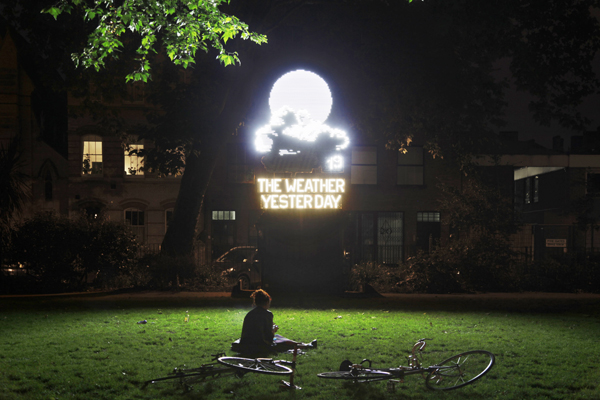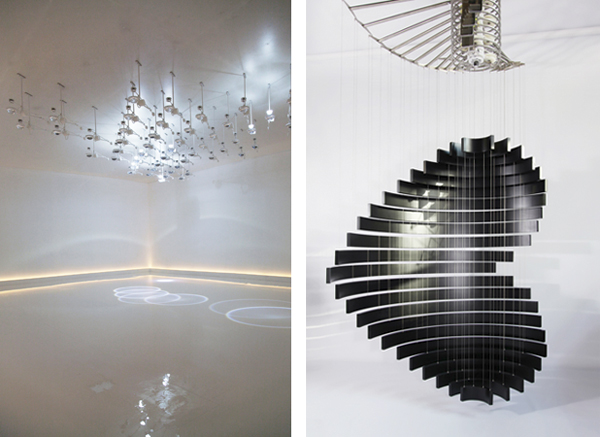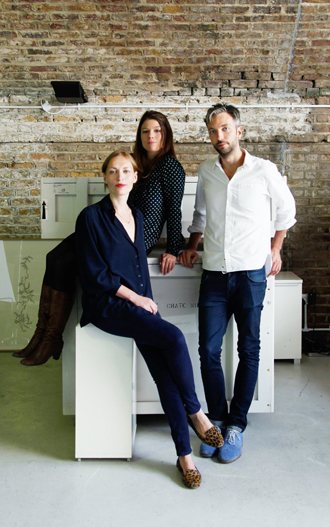Troika questions environment, life

The installations “Falling Light” Provided by the museum
“When I first saw their works at the 2010 edition of World Expo in Shanghai, I knew that I wanted to feature them here in Daelim,” said Kwon Jeong-min, the chief curator, at a press conference at the museum last week.
The three artists say that the start of their journey happened naturally at the Royal College of Art in London.
“In school, we happened to find out that we shared similar perspectives on life,” said Noel.
Freyer added that being able to communicate so well with each other led to strong synergies.
According to the museum, “With a particular interest in perception and the spatial experience, their work explores the intersection of rational thought, observation and the changing nature of human experience through drawings, sculpture and installations.”
When visitors arrive at the museum, they will discover the famous LED installation “Falling Light” shining upon them, with light diffusing into crystal-like circles.
Adjacent to the dark room stands “Electroprobe,” where all kinds of electronics are put together without any sort of order. Viewers will then be introduced to a striking melody - a magnetic microphone revolves around some electronic tools, which range from a television, a radio, a light bulb to a computer.

Left to right: “The Weather Yesterday,” right, are part of the exhibition of the London-based artist group Troika at Daelim Museum in central Seoul. “The Sum of All Possibilities,” a kinetic work made of painted wood and aluminium, is also part of the show.Provided by the museum
The artists then ushered the journalists to their next work, titled “The Weather Yesterday,” an installation that depicts the weather of the previous day. This work, which was originally installed in a park in East London, makes fun of people’s obsession with getting up-to-date information all day, every day. Compared to the outdoor version, the Daelim installation is smaller, but its witty message is still quite amusing.
“The Sum of All Possibilities” evoke the idea of perpetual metamorphoses. While the pattern is simply painted wood, the constantly revolving shapes beguiles viewers.
On the fourth floor, a manic cascade of woven ropes titled “Persistent Illusions” awaits visitors. The three creators noted that the chaotic features of the ropes signify the blurring lines between illusion and reality.

Left to right: Conny Freyer, Eva Rucki and Sebastien Noel
When the Korea JoongAng Daily asked them whether they had gotten any kind of inspiration since arriving in Seoul, Freyer said “the coexistence of high-tech and low-tech in the city” was the most impressive thing.
Freyer described the intersection of analogue and digital worlds in Korea, and Noel excitedly commented on Seoul’s alley culture. “You would never find anything like the electronic shops by Cheonggyecheon stream elsewhere. Cherish it and preserve it; perhaps you should make all those shops into national treasures,” he said.
*The exhibition runs until Oct. 12. Admission is 5,000 won ($4.80) for adults. Hours are from 10 a.m. to 6 p.m. To get to the museum, go to Gyeongbokgung Station, line No. 3, exit No. 3. For more information, call 02-720-0667, or visit www.daelimmuseum.org.
BY KIM HEE-EUN, CONTRIBUTING WRITER [estyle@joongang.co.kr]










with the Korea JoongAng Daily
To write comments, please log in to one of the accounts.
Standards Board Policy (0/250자)